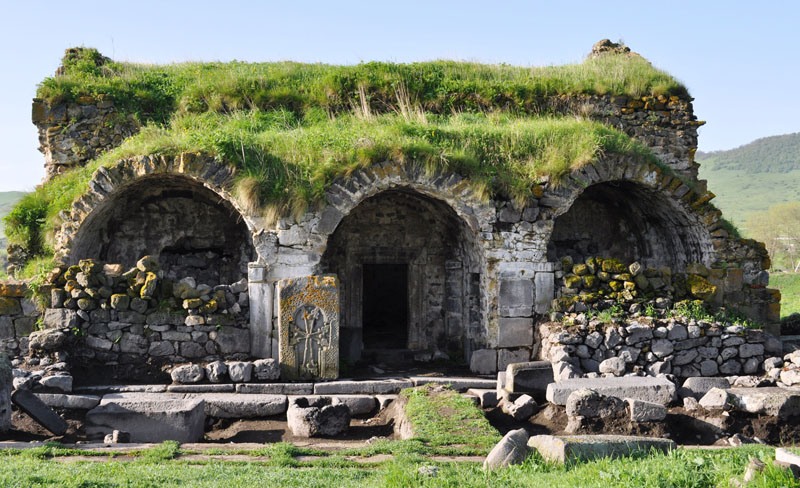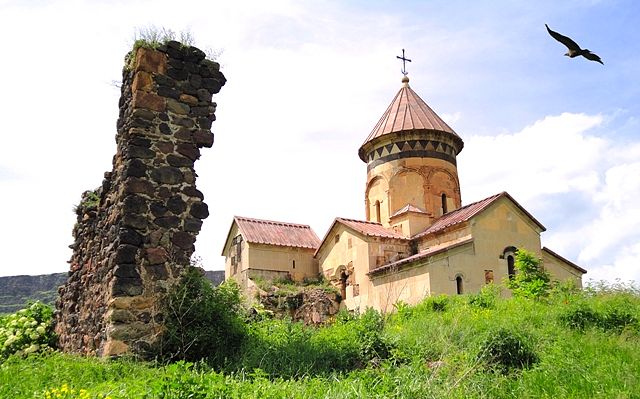Lori Berd
 At the dramatic intersection of the Dzoraget and Urut river canyons is located the remains of 10th century Lori Berd Fortress. The site is known to Stepanavan locals as “Ashot Yerkat” or “Ashot the Iron” in memory of the rule of the king known by this nickname.
At the dramatic intersection of the Dzoraget and Urut river canyons is located the remains of 10th century Lori Berd Fortress. The site is known to Stepanavan locals as “Ashot Yerkat” or “Ashot the Iron” in memory of the rule of the king known by this nickname.
From the center of town, cross the Dzoraget Bridge to the northern bank of the gorge and turn right at the roundabout. Continue east along the road, which parallels the gorge. Continue until you reach the intersection of the main road with that entering into the village of Lori Berd on your right. Turn right at this intersection and continue straight through the village. If you look carefully, you will see stones with distinctive markings built into the walls of some of the village homes. These stones, taken from the original fortifications, bear witness to the fact that the village was relocated from within the walls of the fortress itself to its current site in the 1920s or ‘30s. As you approach the fortress, you’ll find the Lori Berd village cemetery on your right.
At the entrance to the fortress is a picnic area and parking lot which lead to the arched entry gate of the massive walls that once protected the northern side of the settlement. Enter through this gate and follow the concrete walkway, installed during Soviet times, to the bathhouse outside of which are two stone bath tubs, complete with drainage holes. Inside the bathhouse, remains of a complex plumbing system can be found embedded in the interior walls in the form of a double row of clay pipes --presumably for hot and cold water.
Continue along the concrete pathway to find the church which shows proof of the Muslim occupation in its niche carved into the Mecca-facing southern wall. The path leads to the edge of the Dzoraget Gorge and down to a small kitchen or bath structure which once housed a complex system of pipes. From this vantage point, the security that the canyon walls offered is clear, as the cliffs drop off precipitously to the river below.
Exit by the gate and turn right to find the ancient cobbled path switch-backing into the valley to the bridge below. As you descend, you will see a memorial carved into the cliff to your left to a man who fell into the gorge while hunting. The vaulted medieval bridge at the bottom of the gorge crosses the Urut River leading to several carvings of crosses and other designs in the rock face on the other side, as well as to a popular spring to the right. Under the bridge is a perfect picnic spot, complete with barbecue area and fire ring for a teakettle. Perfect to make a good khorovats (barbecue) !
Hnevank

The church is a semi-free triconch structure (meaning that it contains three apses, or semi-circular recesses covered by hemispherical domes, arranged off the main room in the direction of the compass points) towards the east. The monastery’s dome is supported by an octagonal drum. To the west, where the fourth apse of a tetraconch structure would be, is the monastery’s gavit, or arched-ceiling entryway. The gavit was added between 1186 and 1206. The monastery is surrounded by several service buildings such as the monk’s residence.
The route is not complicated; just take the main road out of Stepanavan, pass through the Amrakits village, and veer left when you see the road sign to Gyulagarak, Vardablur, and Kurtan. When you enter Kurtan, turn to your right and continue into the gorge.
After 10-15 minutes of walking, you will see the bottom of the gorge and the remains of the Hnevank monastery, a structure built between the seventh and the ninth centuries. Lord Smbat, of the Orbelian dynasty in Georgia, heavily renovated the church in 1144, after his expulsion from his home country, according to an inscription on the stone structure written in Georgian. The monastery was abandoned during the forced Armenian exodus but with Armenian independence in 1989, it was renovated and returned to its former beauty.
The Dendropark
Founded in 1933 by the forest engineer Edmon Leonovich, the Dendropark Botanical Garden features a diversity of tree species brought from different regions of the world. It is also a place of rest, green and fresh, even during hottest times of summer.
In the 1930s, during his work for the Forestry Commission in the area, Edmon Leonovich started planting ornamental trees on its own initiative. Gradually, he introduced new trees into natural forest clearings which flourished and left the main forest species to be the Siberian pine. Today, the Botanical Garden occupies 35 hectares of which 17.5 are composed of natural forest and 15 of ornamental trees.
It is thought that the Dendropark is the first place in the Trans Caucasus region where the natural forest had been reorganized into a Forest Park. The Botanical Garden is natural Stepanavan forest augmented with ornamental plants and avenues of linden (Tilia cordata), featuring introduced tree specimens such as Juglans, Malus, Populus and Pyrus.
Most of the new species were introduced from other botanical gardens through exchange programs between the Yerevan Botanical Garden and its counterparts around the world. Species have been imported from Germany, France, Portugal, China and the United States. There are now over 500 non-native species.
The collection is of great scientific interest and provides the opportunity to study changes the plants undergo when introduced into these new environmental conditions.
Of particular interest are the greenhouses where Edmon Leonovich’s, cultivates evergreen seedlings for sale to re-forestation programs; the founder remained the Dendropark’s director until 1984, when his son took over the position. The site was designated as a protected site in 1998.
Late April or early May, if you're lucky enough to find yourself in Stepanavan, you can enjoy this unique time to breathe the air scented by blossoming pine trees. Before the fall of the Soviet Union there was a sanatorium near the Dendropark which welcomed children with asthma and other respiratory problems. Today this place, called Sochut, has been completely renovated and offers an ideal retreat for anyone wishing to escape the polluted air of big cities.
Mayori dzor
There is a sign which points the way to the Communists Caves.
Caves of the Communists ("Mayori Dzor" or "The Gorge Commander") are on the edge of the precipitous gorge Dzoraget, they served as secret location for meetings organized by the revolutionary Chahumyan Stepan (1878-1918) who contributed to the imposition of Bolshevik authority in Baku, Azerbaijan.
The site is easy to find, thanks to what remains of changes dating back to Soviet times. At the edge of the gorge there is a small park with a sculpture of Stepan Chahumyan and a staircase that leads right to the caves, down the canyon. On the way you can see engravings on the rocks.